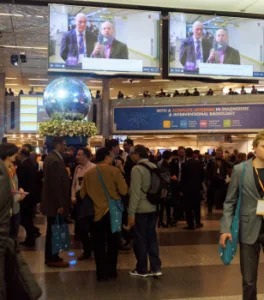This year’s European Congress of Radiology took place, as usual in Vienna. We managed a flying visit in this busy event season to check out the latest in radiology displays. These displays are highly regulated.
Although there are a number of types of specialist “medical” monitors, it is those that are used for medical diagnostics that are the tricky ones. Not only do the displays themselves have to perform very accurately, there have to be QC and audit trails. For example, we heard that German regulations specify that when a calibration is done, the version of the software and the type and serial number of the graphics card used have to be recorded. That needs some careful planning!
The show was busy and even to our untutored eyes, it is clear that imaging is rapidly growing beyond traditional machines. As a result, colour displays are becoming accepted, as long as they can meet the requirements for radiology as well. How the switch is done between viewing modes is becoming a significant competitive point.
As usual, it is interesting to note who wasn’t there. This year, NEC, Wide and NDS Surgical Imaging (which has been using the venerable Dome brand) were missed by observers and competitors. (NEC told us that it is holding a special event at its Munich European HQ next week which will host 60 specially invited guests from around Europe and that several of its partners including Carestream, Visus, Fujifilm and Medtech were at the show with NEC products for all medical applications, not just radiology. The company also had a party with Visus after we had left the show.)
All areas of the radiology and medical imaging business are incredibly regulated and are slow to change. We asked a number of vendors if they had evaluated OLED for radiology as many were bragging of improved contrast of up to around 1,500:1, great for LCD, but way below the level of OLED. However, OLED is seen as too unstable a platform, with serious concern about ‘image sticking’. Major vendors such as Barco and Eizo offer five year warranties (and displays can be used ’round the clock’, so that means a lot of hours), so long term stability is a potentially big issue for vendors.
The other point is that radiology is about ‘Just Noticeable Differences’ (JNDs). A high quality LCD with enough brightness can show around 600 JNDs, but that’s close to the limit of the sensors, as I understand it. Further, the data from the sensors and software has all to be certified and, like aviation, changing that can take years – or even decades! Arguably, a display that has more JNDs than the content is not useful (although the very high contrast that Totoku was showing on a prototype 13.7 megapixel display certainly seemed to reveal more about the shape of tissue than other demos that we had).
Anyway, we saw some interesting things, although the trend for more surgical displays was shown on some booths. This market also has high quality demands (especially for accurate colour) and as the radiology market has flattened in recent years, as most of Europe is now digital rather than film-based, and has become a replacement market, there is a desire to look for new markets.

